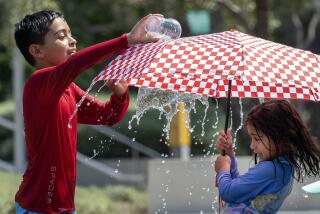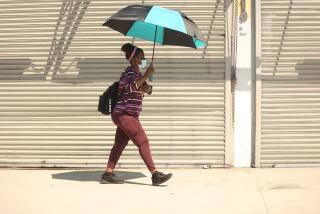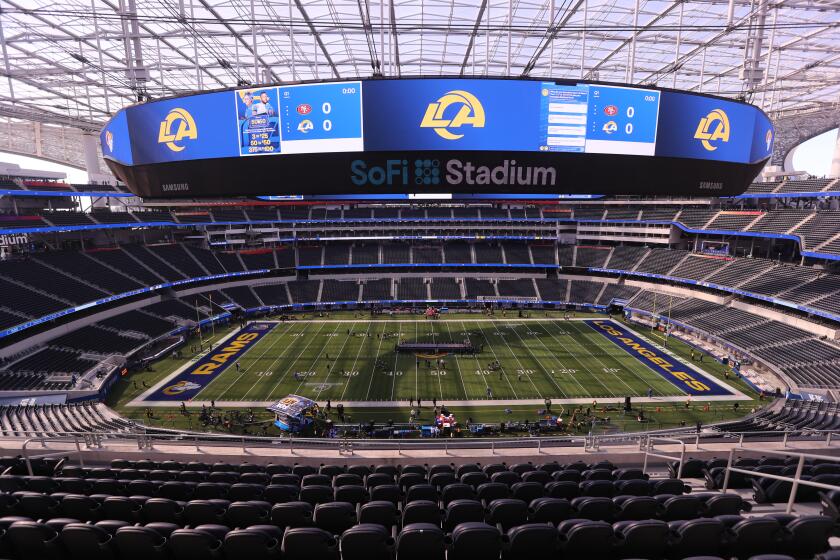Athletes Also at Risk in the Heat, Humidity
- Share via
The elderly and the very young are most at risk for heat-related illnesses, but well-conditioned athletes can also be susceptible.
The combination of heat and high humidity can lead to heat exhaustion and the more severe, sometimes fatal, heatstroke.
Last week, a San Fernando High School football player, Sergio Echevarria, died of heatstroke after a mid-day team workout. On Saturday, UC Irvine soccer player Terrie Cate died three days after collapsing with a 107-degree temperature and elevated pulse during a six-mile training run. An autopsy was performed Sunday by the county coroner’s office, but the official cause of death has yet to be determined, pending results of toxicological tests.
PRECAUTIONS
Precautions against heat-related illnesses include drinking water or juices and taking frequent breaks.
SPECIAL RISKS
Certain conditions and medications can increase the risk.
In July, 1991, three state prison inmates in a Northern California psychiatric ward died of heatstroke, aggravated by medical conditions and the effects of Haloperiodol, a sedative that inhibits the body’s ability to cool itself. The deaths were ruled accidental.
Among the conditions or medications that might increase susceptibility to heat-related illnesses:
* Medication for high blood pressure--Drugs to treat hypertension, particularly diuretics and beta blockers, increase the body’s water loss. These can lead to dehydration and heat illness.
* Immunizations--Fevers are a common reaction to vaccinations, and anything that causes a fever increases susceptibility to heat problems.
* Sunburn and heat rash--Severe sunburns can cause a fever and may decrease the body’s ability to sweat for as long as a week after they occur. Heat rash is an obstruction of the sweat glands and greatly impairs the body’s ability to sweat.
* Tranquilizers, antipsychotic medications and anti-depressants--These drugs all impair sweating and can increase the risk of heat-related illness.
* Excess weight--Overweight people are insulated better and therefore have more difficulty dissipating body heat. Since heavier people might not be in good physical condition, they’re also more likely to overexert.
SYMPTOMS
Symptoms of heat exhaustion include heavy sweating followed by sudden lightheadedness, dizziness, nausea and weakness. Headaches are common.
During heatstroke, sweating often stops and the skin feels hot and dry. The pulse rate is rapid and fainting might occur. When the body temperature goes above 104 degrees, key proteins in the body begin to break down. The kidneys, heart, liver and brain can be damaged. Loss of consciousness is common, and in severe cases, seizures occur and some victims lapse into an irreversible coma.
TREATMENT
For heat exhaustion, the victim should drink water and move out of the sun. If vomiting occurs, stop giving the victim water. If consciousness is lost, the victim should be taken to an emergency room or be seen by a physician. Seek to cool the person, perhaps by hosing them down or giving them a bath or shower. Cool victim with wet cloths.
In cases of heatstroke, treatment must be swift. Call 911; emergency medical care is required. Do not give water to anyone suspected of suffering from heatstroke. Doing so can cause vomiting, worsening dehydration. Get the person into shade or air conditioning and loosen their clothing. Hose them down or immerse the person in water. Put ice on the neck or groin, where blood flow is greatest.
More to Read
Go beyond the scoreboard
Get the latest on L.A.'s teams in the daily Sports Report newsletter.
You may occasionally receive promotional content from the Los Angeles Times.






